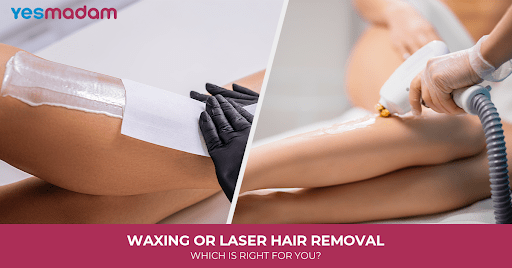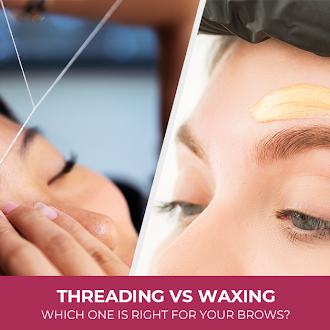
Waxing or Laser Hair Removal: Which Is Right for You?
When it comes to achieving smooth, hair-free skin, the two most popular methods people turn to are waxing or laser hair removal. Both have their loyal fans, and both come with their own sets of benefits and drawbacks. If you’ve ever found yourself torn between scheduling a waxing appointment or committing to a series of laser sessions, you’re not alone. This guide will break it all down in a clear, approachable way—so you can decide whether wax or laser is the better fit for your lifestyle, skin type, and beauty goals.
Table of Contents
What Is Waxing?

Waxing is one of the oldest and most accessible hair removal methods. It involves applying warm or cold wax to the skin, pressing a strip of cloth or paper onto it, and then quickly pulling it away to remove hair from the root. This method can be used on various parts of the body—from eyebrows and upper lips to arms, legs, and even Brazilian waxing.
Pros of waxing:
- Immediate results (smooth skin after one session)
- Can be done at home or in a salon
- Affordable compared to laser
Cons of waxing:
- Temporary results (hair grows back in 3–6 weeks)
- Painful, especially in sensitive areas like bikini lines
- Risk of ingrown hairs, redness, and irritation
More Information For You: How to Use Wax Strips
What Is Laser Hair Removal?

Laser hair removal is a more advanced method that uses concentrated beams of light to target hair follicles, damaging them and inhibiting future hair growth. Unlike waxing, which removes hair from the root, laser works by reducing the follicle’s ability to produce new hair over time.
Pros of laser hair removal:
- Long-term reduction in hair growth
- Sessions become quicker as hair thins
- Can help with ingrown hairs and smoother skin texture
Cons of laser hair removal:
- More expensive than waxing initially
- Requires multiple sessions for best results
- Works best on individuals with lighter skin tones and darker hair
Waxing vs Laser Hair Removal: Key Differences
When weighing waxing vs laser hair removal, it helps to compare them across several factors:
| Factor | Waxing | Laser Hair Removal |
| Cost | Cheaper per session | More expensive upfront, but cost-effective long-term |
| Pain level | Moderate to high (especially first time) | Feels like rubber band snaps, less painful over time |
| Results duration | 3–6 weeks before regrowth | Permanent reduction after multiple sessions |
| Hair type | Works on most hair types | Best for dark, coarse hair on lighter skin tones |
| Convenience | Can be done at home or salon | Requires professional equipment and appointments |
| Skin irritation | Possible redness, ingrown hairs | Temporary redness, less risk of ingrowns after several sessions |
In short, waxing is great if you want quick, short-term results, while laser is ideal if you’re after long-lasting smoothness and are willing to invest in a series of treatments.
Can I Wax After Laser Hair Removal?
A common question people ask is: can I wax after laser hair removal treatment? The short answer is no, you shouldn’t.
Here’s why: laser hair removal targets the hair follicle beneath the skin. Waxing, on the other hand, pulls the hair out from the root. If you wax between your laser sessions, you’re actually removing the very follicles that the laser is supposed to destroy. This makes the treatment less effective and could extend the time it takes to see results.
Instead of waxing after laser, stick to shaving if you need to manage hair between treatments. Shaving only cuts the hair at the surface, leaving the follicle intact for the laser to target during your next session.
Should You Wax After Laser Hair Removal?
If you’re wondering, should you wax after laser hair removal?—the answer is still no. Waxing after laser is not recommended. After a laser session, your skin is more sensitive than usual. Waxing can cause irritation, burns, or even scarring because the skin is already in a vulnerable state.
The best alternative is to shave any regrowth or let the hair fall out naturally. In fact, many clinics will advise against plucking, tweezing, or waxing for at least 6 weeks before and during the course of your treatments to make sure the laser can effectively target the hair follicles.
Don’t Miss: Threading vs Waxing
Can I Wax After Laser Hair Removal Treatment If I Have an Event?
Maybe you’ve just had your first session and have a big event coming up, and you’re tempted to wax for that extra smooth finish. You might be asking: can I wax after laser hair removal treatment if I have something important soon?
Unfortunately, waxing after a laser session can disrupt your results. The better option would be to shave, use a gentle depilatory cream (if your skin isn’t too sensitive), or schedule your laser treatments so they don’t overlap with important occasions. If smooth skin for an event is your main priority, waxing beforehand might be the smarter choice, and then you can begin your laser sessions after.
Wax or Laser for Brazilian Hair Removal?
Another common debate is laser vs waxing Brazilian treatments. Both methods are popular, but they provide very different experiences:
- Brazilian waxing gives instant results, but it can be painful, especially in the sensitive bikini area. You’ll also need to repeat the process every 3–5 weeks, and ingrown hairs are fairly common.
- Laser hair removal for Brazilian areas provides long-term reduction, and after a few sessions, you may not need to worry about frequent regrowth. While the initial discomfort can be similar to a rubber band snapping against the skin, most people find it more tolerable than waxing after the first few treatments.
If you’re looking for a permanent solution and want to avoid repeated appointments, laser might be the better investment. But if you’re not ready to commit, waxing is a flexible option.
What to Expect During Waxing
When you go for a waxing session, the technician will usually cleanse the skin, apply warm wax in the direction of hair growth, and then quickly pull it off with a strip or by hand (if using hard wax). Each pull removes hair directly from the follicle, leaving the area smooth.
The whole process can take anywhere from 15 minutes (for smaller areas like the upper lip) to an hour (for full legs or Brazilian). Afterward, you might experience redness or small bumps, but these usually fade within a day or two.
What to Expect During Laser Hair Removal
A laser session feels very different. The technician uses a handheld device that emits pulses of concentrated light. When the light hits the hair follicle, it damages the root, slowing or completely stopping future growth.
Most people need between 6–8 sessions, spaced about 4–6 weeks apart, for optimal results. After each session, some hairs will fall out on their own over the following days or weeks. While you may notice patchy regrowth initially, it usually becomes finer and less noticeable with time.
Who Is a Good Candidate?
Laser hair removal works best on people with light to medium skin tones and dark, coarse hair because the laser targets the pigment in the hair follicle. Advances in technology, however, now make it possible for people with darker skin tones to safely undergo treatment, though multiple sessions may be required.
Waxing, on the other hand, is suitable for almost everyone regardless of skin or hair type. That’s why some people still prefer waxing over laser, especially if they have light or fine hair that laser may not effectively target.
Pain Levels: Waxing vs Laser Hair Removal
One of the biggest factors in the waxing vs laser hair removal debate is pain. Waxing pulls out hair directly from the root, which can be quite painful—especially in sensitive areas like the bikini line or underarms. However, many people find the discomfort decreases after a few sessions as the hair becomes finer.
Laser treatments, while often described as feeling like a rubber band snap or a warm pinprick, are usually less painful in the long run. Most modern clinics also use cooling systems to make the experience more comfortable.
Related Blog: Rica Wax Benefits
Cost Comparison: Waxing or Laser Hair Removal
At first glance, waxing looks much more affordable. A single waxing session can cost anywhere from $30 to $80 depending on the area, while laser sessions may range from $100 to $500 each.
However, waxing is an ongoing expense. Since hair grows back every few weeks, you may spend thousands of dollars over the years. With laser, you might need several sessions upfront, but the long-term reduction means you’ll likely save money and time in the future.
So, while the upfront price tag for laser may seem high, in the battle of waxing or laser hair removal, laser often wins for those looking at it as a long-term investment.
Safety Considerations
Both waxing and laser hair removal are generally safe when done by trained professionals. Still, there are some risks to keep in mind:
- Waxing risks: Ingrown hairs, temporary redness, burns from overheated wax, or skin irritation.
- Laser risks: Temporary redness, swelling, mild discomfort, and in rare cases, pigmentation changes.
If you have sensitive skin, always do a patch test first. And regardless of the method you choose, follow aftercare instructions carefully.
Aftercare Tips for Waxing and Laser Hair Removal

Your skin needs some extra TLC after both waxing and laser sessions. Here are some tips:
- Avoid hot showers, saunas, and direct sun exposure for at least 24–48 hours.
- Skip perfumed lotions or harsh skincare products on treated areas.
- Use soothing aloe vera gel or a fragrance-free moisturizer to calm irritation.
- Wear loose-fitting clothing to avoid friction.
Long-Term Results: What You Should Know
If your main goal is permanent hair reduction, laser is the clear winner. After completing your treatment sessions, many people see a 70–90% reduction in hair growth. Maintenance treatments might be needed once or twice a year.
Waxing, while effective in the short term, will always require repeat sessions to maintain smoothness. The benefit is that hair may grow back finer and softer over time, but it won’t permanently disappear.
Conclusion: Waxing or Laser Hair Removal: Which Should You Choose?
Deciding between waxing or laser hair removal really comes down to your goals, budget, and tolerance for discomfort. If you want a quick, affordable fix and don’t mind regular upkeep, waxing could be your go-to option. But if you’re tired of constant regrowth and want a more permanent solution, laser hair removal is worth the investment.
Remember: you should not wax after laser hair removal because it can reduce the treatment’s effectiveness and irritate your skin. Instead, opt for shaving or trimming between sessions. When it comes to waxing vs laser hair removal, there’s no one-size-fits-all answer—it depends on what feels right for you.
The bottom line? Whether you choose wax or laser, both methods can help you achieve smoother, more confident skin. The key is understanding the differences, managing your expectations, and choosing the method that aligns with your lifestyle.
FAQs
1. Is waxing or laser hair removal more painful?
Waxing can be more painful because it pulls hair directly from the root, especially in sensitive areas. Laser feels like a rubber band snap and usually becomes more tolerable after the first few sessions.
2. Can I wax after laser hair removal?
No, you should not wax after laser hair removal. Waxing removes the hair from the follicle, which interferes with the laser’s ability to target and destroy it effectively.
3. Should I wax after laser hair removal to get smoother results?
It’s not recommended to wax after a laser session. The skin is sensitive, and waxing can cause irritation, burns, or disrupt the treatment. Shaving is a safer option between laser sessions.
4. What’s better: wax or laser for long-term hair removal?
If you’re looking for permanent hair reduction, laser hair removal is the better option. Waxing is great for temporary smoothness but requires ongoing maintenance every few weeks.
5. How many laser hair removal sessions do I need?
Most people need between 6 to 8 sessions, spaced 4–6 weeks apart, for the best results. Some may need occasional maintenance treatments afterward.
6. Is laser vs waxing Brazilian really worth it?
Yes, many people find laser vs waxing Brazilian treatments more effective long-term. While waxing offers immediate results, laser reduces regrowth significantly, meaning less maintenance over time.
7. Can I shave after laser hair removal instead of waxing?
Yes, shaving is the recommended method for managing hair between laser sessions. Unlike waxing, shaving doesn’t remove the follicle, so the laser can still target the root effectively.
8. Does waxing cause ingrown hairs?
Yes, waxing can sometimes cause ingrown hairs because it pulls the hair out from the root. Proper exfoliation and moisturizing can help reduce the risk.
9. How soon can I start laser hair removal after waxing?
It’s best to wait at least 4–6 weeks after your last wax before starting laser treatments. This ensures enough hair has grown back into the follicle for the laser to target effectively.
10. Which is more cost-effective in the long run, waxing or laser hair removal?
Waxing may seem cheaper at first, but because it requires repeat treatments every few weeks, the costs add up over time. Laser requires a bigger upfront investment but often saves money in the long run due to permanent results.



